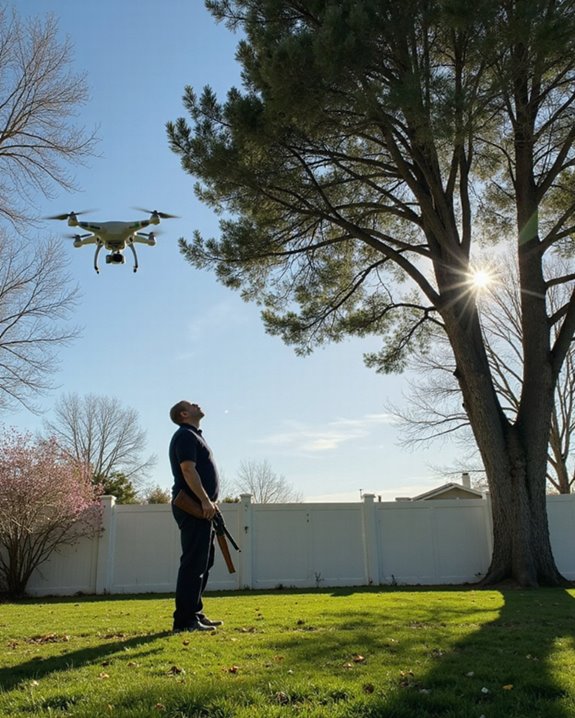It’s absolutely illegal to shoot down a drone in California—no matter how annoying that buzzing may seem! Drones are protected as aircraft under federal law, so firing your slingshot or grabbing your garden rake can lead to felony charges, hefty fines, or even years in prison. Even grabbing a broom is a big no-no, because tampering with drones is serious business. Want to know what you are allowed to do when a drone flies overhead? There’s a lot you’ll want to know next!
Key Takeaways
- Shooting down a drone in California is illegal and considered destruction of an aircraft under federal law.
- Destroying a drone can lead to felony charges and up to 20 years in prison.
- Homeowners cannot use firearms or objects to interfere with drones, regardless of privacy concerns.
- Legal remedies for nuisance drones include restraining orders, lawsuits, and reporting to law enforcement or the FAA.
- Drone owners can sue for property damage if their drone is unlawfully shot down.
Federal and State Drone Regulations in California
When it comes to flying drones in California, there’s a whole sky full of rules to keep in mind—seriously, it’s not just about zipping your new gadget around the backyard! FAA Compliance is a huge deal here: drones over 0.55 pounds must be registered, and every drone will need to broadcast a Remote ID signal by 2025. You can’t just fly above 400 feet or near airports and military bases—those are strict no-fly zones. Hobbyist Training is encouraged, so beginners know about visual line of sight and where to avoid restricted airspace, like wildlife refuges. Commercial pilots and even foreign visitors must have a license and register their drones, too. California’s blend of state and federal rules keeps everyone, and every drone, on their best behavior! To meet these regulations effectively, many drone operators are turning to FAA Compliant Remote ID Modules for reliable identification broadcast.
Privacy and Trespass Laws Affecting Drone Operations

Peeking into someone’s backyard with a drone might sound like something out of a spy movie, but in California, privacy and trespass laws take that seriously—and so should you! Drone Ethics are at the heart of these laws. Under Civil Code Section 1708.8, it’s illegal to use drones to record people without their permission, especially during personal activities. If you think you’re just “flying by,” remember that Trespass History applies—flying over private property without consent may count as trespass. Civil Code Section 3481 even says drone noise can be a nuisance! Local rules can vary, so what’s okay in one city might not be in another. California’s legal toolbox includes restraining orders, fines, and even criminal charges for privacy violations. It is also important to note that signal blocking technologies like Mission Darkness Recon Shield exist but are heavily regulated and illegal for civilian use.
Legal Boundaries for Homeowners Confronting Drones
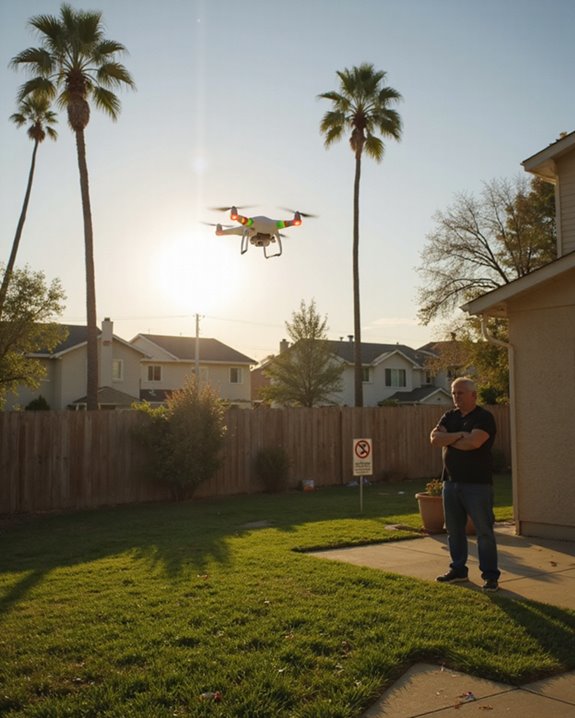
Ever wondered what you’re actually allowed to do if a drone is buzzing over your backyard, maybe even catching you mid–barbecue? California law, plus federal rules, say you can’t grab your garden hose or slingshot and take action! Shooting down or interfering with a drone is illegal—drones are classified as aircraft, so even a well-aimed tennis ball could get you in real trouble. Instead, homeowner training programs and advocacy networks encourage residents to learn their rights and communicate with drone operators. If a drone is truly a nuisance, your first move should be reporting the incident to local law enforcement or the FAA. Remember, open conversation—sometimes with a dash of neighborly charm—often solves these buzzing backyard problems before they escalate. For commercial drone operators, obtaining FAA certification is legally required to ensure safe and compliant flights.
Civil Code Provisions on Aerial Surveillance

If a drone is buzzing over your backyard, it can feel like you’re suddenly on a reality TV show—minus the prize money! California’s Civil Code Section 1708.8 is a key example of how Historical Provisions shape today’s drone laws, making it illegal to snap photos, record video, or capture audio of people in private moments without their consent. These rules create an Ethical Framework, balancing technological advances with privacy rights. Trespass laws also matter, as drones don’t need to land to cause trouble—if they disrupt your enjoyment of your property, that’s a problem. Penalties for misuse are real: fines and legal action are possible if privacy is breached. Exemptions exist for some, but most drone operators must follow strict legal boundaries.
Noise, Nuisance, and Eavesdropping Concerns
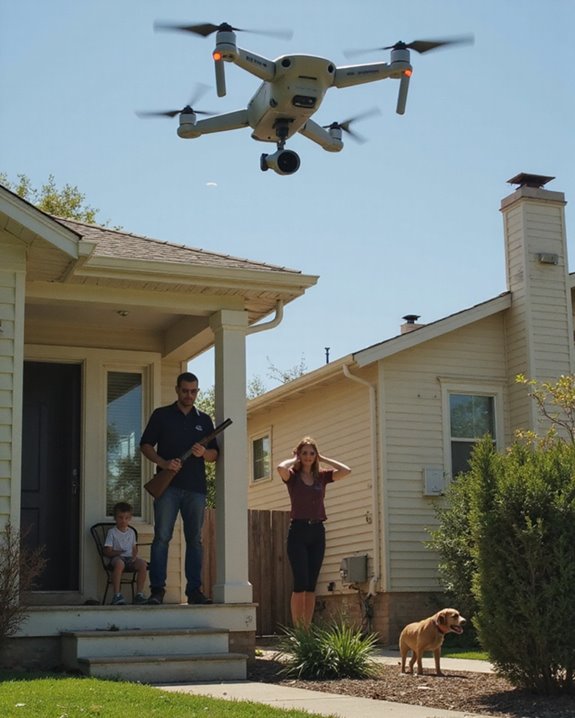
A buzzing drone overhead isn’t just a futuristic curiosity—it can be a real source of frustration for Californians! The constant drone propeller noise, especially from FPV models, often disrupts the peace, leading to complaints under HOA “nuisance” rules. Imagine trying to relax in your backyard, only to feel like you’re in a beehive! California Civil Code Section 3481 lets residents fight back against disruptive noise, protecting their health effects and peace of mind. Wildlife impact is a worry, too—skittish pets and birds may scatter at the unfamiliar sound. Privacy laws, such as Penal Code Section 632, prohibit drones from recording conversations or private moments without consent, aiming to prevent eavesdropping and unwanted surveillance. Neighborhood harmony depends on everyone respecting these boundaries!
Consequences of Shooting Down a Drone
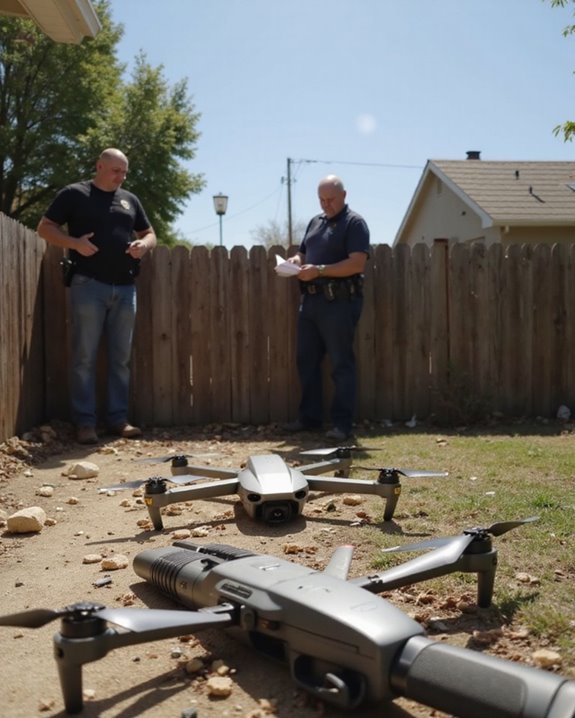
While shooting down a pesky drone might sound like a satisfying way to reclaim your backyard, the legal fallout is no laughing matter! Under federal law, drones are actually considered aircraft—so blasting one from the sky can land a person in serious hot water. We’re talking felony charges, possible prison time up to 20 years, and fines that could empty your wallet faster than a drone can fly away. Plus, the FAA may slap you with civil penalties, and the drone’s owner could sue for property damage. The economic fallout doesn’t stop there: legal fees, compensation, and maybe even reputational damage in your community could follow. State and local police don’t take kindly to these incidents, either—so think twice before reaching for that slingshot!
Emergency Response and Interference Restrictions
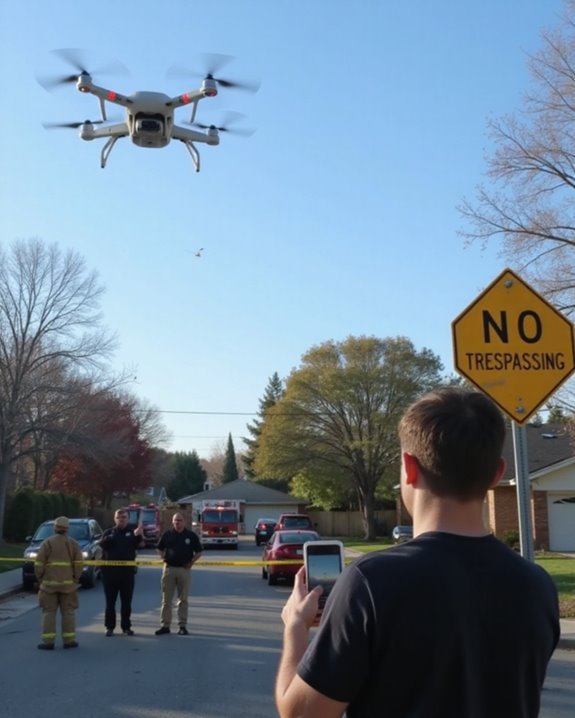
Think swatting a drone out of the sky sounds risky? It’s even riskier around emergency scenes! California law says it’s a misdemeanor to fly drones that interfere with first responders, including firefighters and police during Emergency Drills or real emergencies. Imagine a drone buzzing into a fire zone while crews are following strict Safety Protocols—now that’s a recipe for trouble. Violators can face fines and other legal headaches. Local ordinances and Temporary Flight Restrictions (TFRs) often ban drones over accident sites or disaster areas, so pilots must know the rules before takeoff. If a drone gets in the way, first responders have liability protection if they damage it. Ultimately, keeping emergency workers safe and effective is the top priority—drones need to stay clear!
Liability for Property Damage and Personal Injury
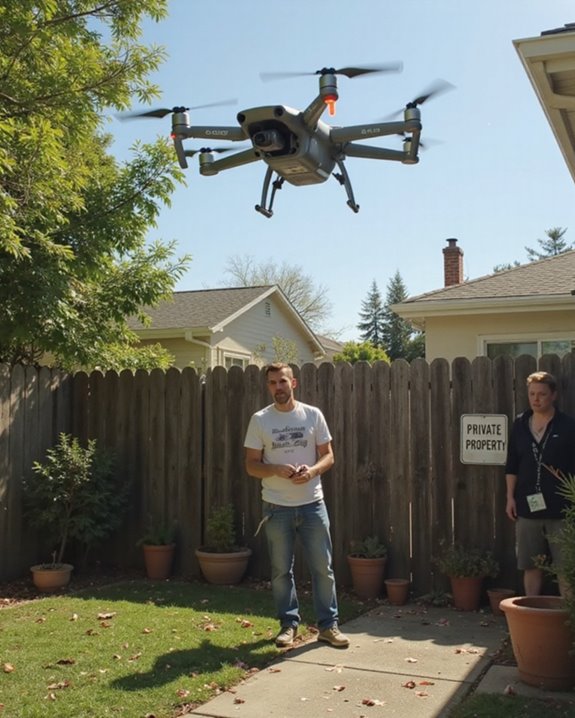
Liability for property damage and personal injury is a huge deal when it comes to drones zipping around California skies! If a drone operator crashes into someone’s house, car, or even a backyard barbecue, they face serious liability risks. California law says drone owners are responsible for any harm their drones cause, whether it’s a smashed window or a nasty cut from spinning blades. That’s why liability insurance—often with at least $1 million in coverage—isn’t just smart, it’s basically a must-have compensation strategy. If someone is injured, proving negligence is key, so things like flight logs, photos, and witness statements matter a lot. FAA violations? That adds even more trouble! At the end of the day, careful flying and good insurance keep drone drama to a minimum.
Local Ordinances and No-Fly Zones
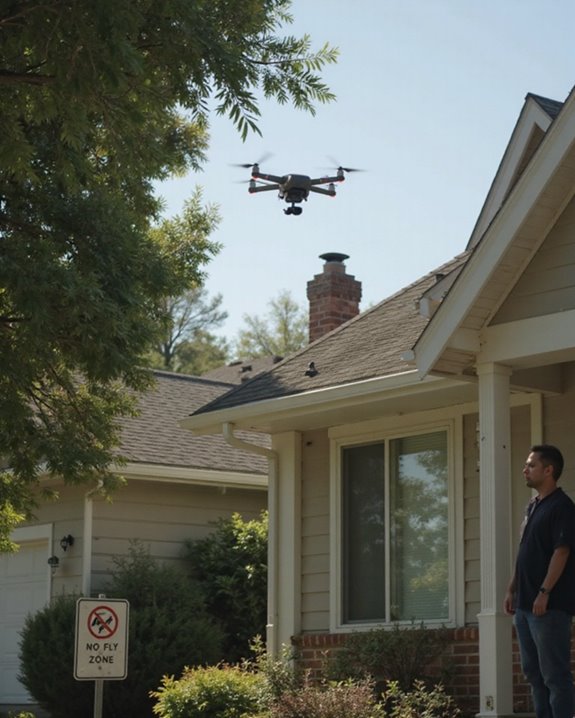
Handling drone rules in California can feel like piecing together a giant puzzle, since local ordinances and no-fly zones are everywhere and often confusing! Every city or town might have its own rules—Los Angeles could restrict drone flights near schools, while San Francisco might focus on noise regulations. Local Enforcement gets tricky fast, because you have to check both city and county websites for up-to-date maps and rules. Zone Mapping becomes essential; apps or online tools help pilots avoid flying near airports, national parks, or during special events. State parks? Many ban drones except in designated spots! Violating these mapped zones can lead to fines or even misdemeanor charges. So, before a drone takes flight, a little research and some careful Zone Mapping can save a lot of trouble!
Legal Remedies for Victims of Drone Misuse
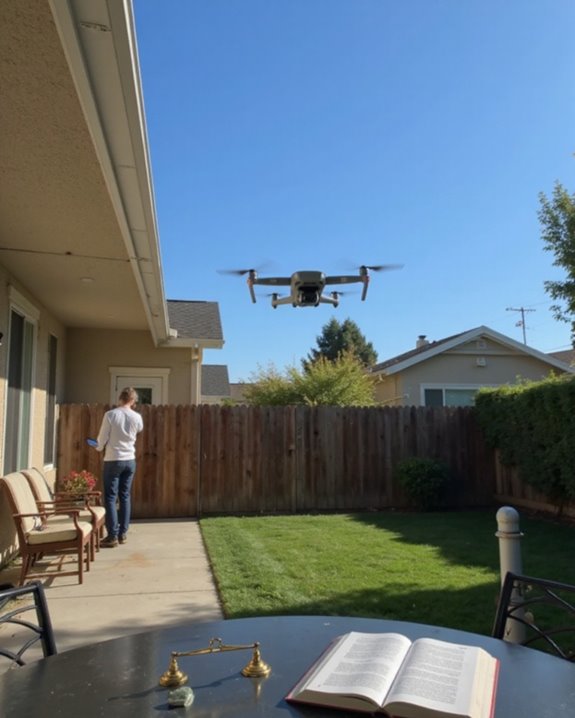
For anyone who’s ever watched a drone buzz a little too close for comfort, it’s reassuring to know there are real steps you can take if your privacy gets invaded! California law, like Civil Code Section 1708.8, gives victims powerful tools—think temporary restraining orders and injunctions—to keep nosy drone pilots at bay. If someone’s drone invades your space, you can sue for damages, and courts may even order the offender to stop flying over your home. Victim Advocacy groups can help guide you, making legal action feel less overwhelming. Sometimes, Mediation Strategies—like meeting with the drone operator—can resolve things without drama (and no superhero capes required). Calling law enforcement is always an option, especially if things escalate. Your privacy matters, and California law has your back!
Frequently Asked Questions
Can Drone Owners Install Anti-Drone Technology to Protect Their Property?
Drone owners may not legally install anti-drone technology to protect their property. Drone laws prohibit private use of such devices, despite privacy concerns. Only certain federal agencies are authorized, and violations can result in fines or other penalties.
Are Drones Allowed to Fly Over Public Beaches in California?
Drones are generally permitted to fly over public beaches in California, but operators must respect beach privacy and comply with local regulations. Restrictions may apply to protect wildlife impact, sensitive habitats, or during periods of elevated fire danger.
Do Drones Need to Display Identification Numbers While Flying?
Federal regulations require visible ID compliance for drones, meaning identification numbers must be displayed during flight. While these numbers promote accountability, number privacy concerns may arise, especially considering the need to balance transparency with operator security and data protection.
Can Neighborhood Associations Set Their Own Drone Rules?
Neighborhood associations possess limited Association Authority to set their own drone rules through Community Bylaws, applying mainly to residents and members. However, these rules must align with federal and local regulations, without jurisdiction over non-members or broader airspace.
Are There Special Drone Rules for Filming Movies or Commercials?
With over 70% of California film productions utilizing aerial shots, special drone rules apply, requiring filming permits, adherence to commercial exemptions, FAA regulations, local approvals, and insurance—particularly in densely populated or environmentally sensitive locations throughout the state.

